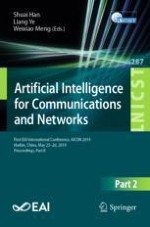2019 | Buch
Artificial Intelligence for Communications and Networks
First EAI International Conference, AICON 2019, Harbin, China, May 25–26, 2019, Proceedings, Part II
herausgegeben von: Shuai Han, Liang Ye, Weixiao Meng
Verlag: Springer International Publishing
Buchreihe : Lecture Notes of the Institute for Computer Sciences, Social Informatics and Telecommunications Engineering
